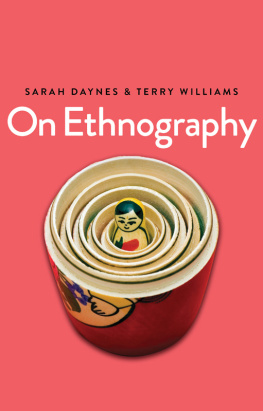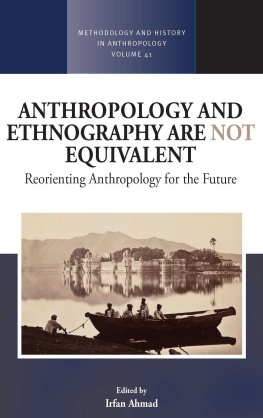Sarah Daynes - On Ethnography
Here you can read online Sarah Daynes - On Ethnography full text of the book (entire story) in english for free. Download pdf and epub, get meaning, cover and reviews about this ebook. year: 2018, publisher: Polity Press, genre: Romance novel. Description of the work, (preface) as well as reviews are available. Best literature library LitArk.com created for fans of good reading and offers a wide selection of genres:
Romance novel
Science fiction
Adventure
Detective
Science
History
Home and family
Prose
Art
Politics
Computer
Non-fiction
Religion
Business
Children
Humor
Choose a favorite category and find really read worthwhile books. Enjoy immersion in the world of imagination, feel the emotions of the characters or learn something new for yourself, make an fascinating discovery.
- Book:On Ethnography
- Author:
- Publisher:Polity Press
- Genre:
- Year:2018
- Rating:4 / 5
- Favourites:Add to favourites
- Your mark:
- 80
- 1
- 2
- 3
- 4
- 5
On Ethnography: summary, description and annotation
We offer to read an annotation, description, summary or preface (depends on what the author of the book "On Ethnography" wrote himself). If you haven't found the necessary information about the book — write in the comments, we will try to find it.
On Ethnography — read online for free the complete book (whole text) full work
Below is the text of the book, divided by pages. System saving the place of the last page read, allows you to conveniently read the book "On Ethnography" online for free, without having to search again every time where you left off. Put a bookmark, and you can go to the page where you finished reading at any time.
Font size:
Interval:
Bookmark:


Copyright Sarah Daynes and Terry Williams 2018
The right of Sarah Daynes and Terry Williams to be identified as Authors of this Work has been asserted in accordance with the UK Copyright, Designs and Patents Act 1988.
First published in 2018 by Polity Press
Polity Press
65 Bridge Street
Cambridge CB2 1UR, UK
Polity Press
101 Station Landing
Suite 300
Medford, MA 02155, USA
All rights reserved. Except for the quotation of short passages for the purpose of criticism and review, no part of this publication may be reproduced, stored in a retrieval system or transmitted, in any form or by any means, electronic, mechanical, photocopying, recording or otherwise, without the prior permission of the publisher.
ISBN-13: 978-0-7456-8559-5
ISBN-13: 978-0-7456-8560-1(pb)
A catalogue record for this book is available from the British Library.
Typeset in 11 on 13 pt Sabon
by Toppan Best-set Premedia Limited
Printed and bound in Great Britain by CPI Group (UK) Ltd, Croydon
The publisher has used its best endeavours to ensure that the URLs for external websites referred to in this book are correct and active at the time of going to press. However, the publisher has no responsibility for the websites and can make no guarantee that a site will remain live or that the content is or will remain appropriate.
Every effort has been made to trace all copyright holders, but if any have been inadvertently overlooked the publisher will be pleased to include any necessary credits in any subsequent reprint or edition.
For further information on Polity, visit our website: www.politybooks.com
There is another world, but it is in this one.
Ignaz Troxler, via Paul luard
The ideas and materials for this book were assembled with the assistance of many mentors, colleagues, friends, and people we met along the way who have read and sometimes written for us, provided us with feedback and advice, engaged with us in discussions, shared their fieldnotes, provided advice on anything from design to technology to writing, and opened up to us about their experiences in the field. The assistance they offered provided an important contribution to the making of this book in more ways than they know. Thus we deeply thank Jeffrey Alexander, Ken Allan, Elijah Anderson, Andrew Arato, Vernon Boggs, Shelly Brown-Jeffy, Steve Cureton, Sophie Diallo, Erwan Dianteill, Mitchell Duneier, Agns Gautier, Frdric Gautier, Alice Goffman, Hakim Hasan, Sharon Hays, Danile Hervieu-Lger, Nancy Hodges, Daniel Huebner, Lannec Hurbon, Bernard Monte Issac, William Kornblum, Steve Kroll-Smith, Marie-Claire Lavabre, Orville Lee, Hylan Lewis, Brian Malek, Peter Martin, William Milberg, Monica, Franoise Morin, Arthur Murphy, Catherine Murphy, Philip Oberlander, Jim Petersen, Jackie Phillips, Alexander Riley, Jonsara Ruth, Philip Smith, Carol Stack, Mats Trondman, Teun Voeten, Sarah Wagner, Saundra Westervelt, Robert Wiley, Paul Willis, and Kevin Yelvington.
We thank our students at the New School for Social Research, the University of North Carolina, Princeton University, and Columbia University, including Adrian Leung, Leslie Ribovich, Adam Bailey, Amy Donovan, Marisol Lpez-Menndez, Peter Marina, Erin O'Connor, Charles Du, Rachel Ferguson, Tim Jacks, Rina Bliss, Mark Flora, Tom Turner, Scott Beck, Ye Lui, Rezvaneh Ganji, and Dara Levendosky.
At Polity Press we wish to thank our anonymous reviewers and we warmly acknowledge the help and guidance provided by our editor Jonathan Skerrett as well as by Neil de Cort, Helen Gray, Elen Griffiths, Rachel Moore, and Amy Williams.
Although all of the aforementioned assisted in some way to the completion of this book, we take complete responsibility for any of its shortcomings.
The Mission
The most common thing is the mission, Shayna says, and continues:
The mission is going to get drugs. Period. Whether it's in the street, in a private spot, or whatever. Most of the time, if you're in a group, you go out on a mission to bring back to the group. Some of the time you go out on an individual mission. But the mission could be to go out to find a guy who is dealing with some drugs and wants to get buffed. It could be to get customers to take them to the spot so you could get yourself a p-c, percentage of the drug sale. The mission could be to vic, to take off somebody. All right? Those are the actual types of missions.
The mission is played out in the darkness of the city, in the hope that daylight will not arrive until the deed is accomplished. Until the pipe is clenched between burnt lips and the smoke is anchored in darkened, exhausted lungs, until the head rests in a familiar stuporous hallucination, the mission is a kaleidoscope of fallen promises, a camp of walking wounded who are at one moment predator, another prey. The thirst for the smoke binge must be quenched, and the nightly maneuvers exemplify only one manner in which it is done.
It's late on an August Saturday night. Headache, Joan, Venus, TQ, and Monica's friend Bunny are at the crackhouse, but all the crack is gone. The pipes are cool, and everyone is jittery. This situation, called the monkey, is common. Monica offers to go out on a mission to get more crack, but only 10 dollars can be scraped up, hardly enough to purchase a half-gram. Headache promises to give her more if a friend shows up who owes him money. She waits a few more minutes, then decides to go on her way. On an impulse, I walk out with her. It is now three-thirty in the morning.
We walk south, past Mambi's restaurant, Diego's meat house, and several beggars. There is a flurry of activity near each corner. It is a cool night and getting cooler. Sugar's bar is open and has few customers; Tiny's after-hours spot in the basement next door is also open. Some stretches of sidewalk are broken, mostly, it seems, in front of stores owned by those who speak English; new concrete appears in front of stores owned by Dominicans. The city is responsible for making these repairs at the property owner's request, but the word is that connections help here too. There are fewer head shops (stores specializing in drug paraphernalia) than there were five years ago, because music shops, candy stores, drugstores, restaurants, and grocerias like Santana's all sell mini-torches, baking soda, beer, and little debbie cookies just about everything compulsive crack users need.
We stop by at three buildings along Broadway, but there is no activity in any of them. Finally, we turn toward Riverside Drive. As we walk, Monica talks sadly.
I know this little girl, Jennifer, who's on crack. She's 15. She's around here somewhere. I tried to get her to stop smoking, but she wouldn't. You know, Scotty takes no hostages. I see her and she's all dirty and shit, wearing the same clothes for five days, but she won't stop smoking that crack. No way will she stop.
We enter yet another building, looking for one of the spots that Monica is convinced will have the best crack-cocaine. In the lobby, Frank, a dealer, offers her a two-dollar piece of crack he has rolled up in a dollar bill. He says all the places on the lobby floor are closed, and there is nothing to buy. Monica has not asked me for money and, as far as I know, has only the 10 dollars she collected in the apartment, two of which are now gone. We go into an adjacent building and walk up to a second-floor apartment. A Puerto Rican girl in her teens sits near the door, arms folded, and before Monica can say anything announces that this place is closed.
Next pageFont size:
Interval:
Bookmark:
Similar books «On Ethnography»
Look at similar books to On Ethnography. We have selected literature similar in name and meaning in the hope of providing readers with more options to find new, interesting, not yet read works.
Discussion, reviews of the book On Ethnography and just readers' own opinions. Leave your comments, write what you think about the work, its meaning or the main characters. Specify what exactly you liked and what you didn't like, and why you think so.










![Kim Fortun - [Article] Ethnography in Late Industrialism](/uploads/posts/book/62624/thumbs/kim-fortun-article-ethnography-in-late.jpg)